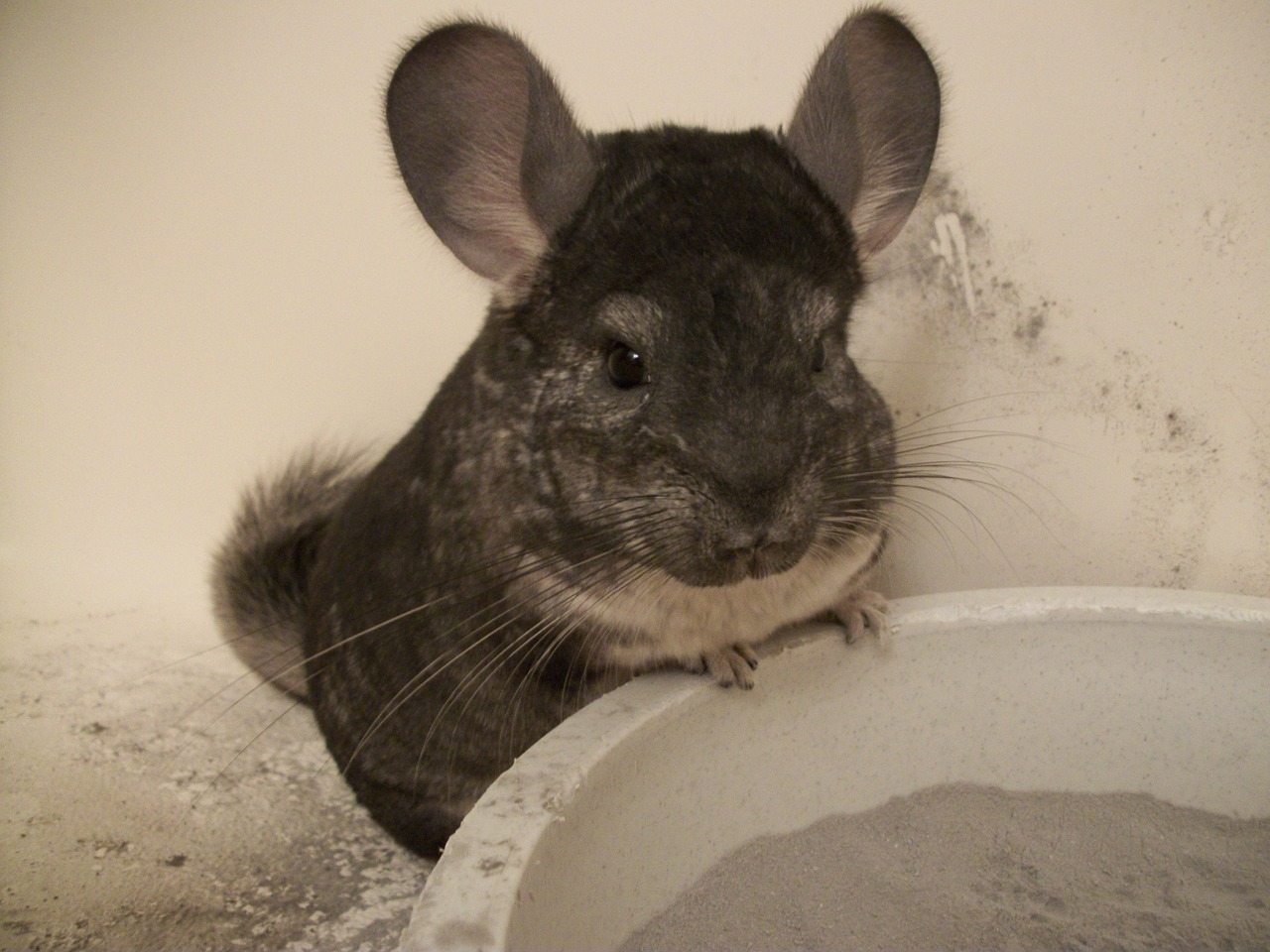An important aspect of pet ownership is proper pet care. With dogs and many other pets, you know you have to bathe them to keep them clean. But what about chinchillas? Can chinchillas take a water bath?
Chinchillas must not take a water bath. Their fur is not water repellent but soaks up water. This causes chinchillas to become hypothermic and catch a cold, which can be fatal to them. Instead, use special chinchilla dust or sand bath.
Chinchillas are somewhat special when it comes to their care. A water bath is not suitable for them. However, they love a nice dust bath, which they use to keep their fur clean.
Let’s take a closer look at why chinchillas can not take a bath and what you should do if your chinchillas get wet. We will also discuss how to keep your chinchillas clean.
We explain how to prepare a dust or sand bath, how often chinchillas need such a bath, and what happens if they don’t get a dust bath.
Can Chinchillas Take a Water Bath?
Chinchillas are not allowed to take a water bath. Their fur is not designed for a water bath.
The fur of chinchillas protects them well from moderate heat and cold, but it is not made for humid areas. They can handle temperature changes very well, but not humidity.
This is due to their original home. Wild chinchillas live in the high altitude Andean regions of Peru, Chile, Bolivia, and Argentina. There they live at altitudes of up to 16,400 ft.
The climatic conditions there are indeed very harsh, with strong temperature fluctuations. Warm summer days can be followed by freezing nights. But it is also a rather dry region. Protection from moisture was therefore not so important for chinchillas.
Nevertheless, of course, chinchillas need water to drink. Offer your chinchillas drinking water best in a water bowl. This corresponds most closely to their natural drinking behavior. They will also make sure that they do not use the water for bathing.
Why Should Chinchillas Not Get Wet?
As mentioned above, water baths are not suitable for chinchillas. Their fur is not water repellent but will soak up the water.
This can cause your chinchillas to get hypothermia. As a result, chinchillas will get a cold. Such colds are often fatal for chinchillas.
For this reason, chinchillas should not be kept outside. Humid air is enough to make their fur damp and then leads to such a cold.
If you live in a hot, dry region, you should still not keep your chinchillas outside. They also cannot tolerate excessive heat. Temperatures above 77 f can cause heatstroke in them.
Chinchillas do not have sweat glands with which to regulate their body temperature. Therefore, wild chinchillas also spend hot days in their living dens and become active only in the evening.
So, in summary, humidity is not healthy for chinchillas. Humidity is even deadly for them!
What Should I Do if My Chinchilla Gets Wet?
If your chinchillas get wet for any reason, you should help them get dry again as soon as possible.
For tame chinchillas that you can take in your hand, you should dab them with a soft towel. To do this, put the chinchilla on the towel and gently wrap it around him.
Then carefully dab off the water. Do not rub the chinchilla, this will irritate it and cause stress. Simple dabbing is quite enough. You won’t get him completely dry with this, but some of the water will be absorbed by the towel.
If you have a heat lamp, you should point it at your chinchilla cage. This will help keep your chinchillas from getting chilled. Remember, though, that chinchillas can’t tolerate temperatures that are too high. More than 77 f is not good for them.
It is best to put a thermometer in the cage with them to monitor the temperature. Place the heat lamp a little further away in case the temperature gets too high. You need to find the balance between hypothermia and overheating.
How Do I Clean My Chinchillas?
An essential part of fur care and well-being for chinchillas is dust or sand bathing. However, use only special chinchilla bathing dust* or chinchilla bathing sand* for this purpose.
Bird sand is too coarse and damages the sensitive fur. Bird sand also often contains additives that are harmful to chinchillas, such as anise grains.
Specially rounded quartz sand is suitable, as well as various pumice, clay, or terrarium sand. Attapulgus or also sepiolite sand can lead to lung problems or even lung cancer due to sharp splinters. Good sand absorbs moisture and thus also serves fur care.
Less suitable are coarse building sand, sandbox sand, coarse quartz sand, or the already mentioned bird sand. These types of sand also clean the coat, but the rough edges cause split ends if used constantly.
Bird sand also often contains anise, which the animals do not like to smell, and sharp-edged shell grit, which can lead to injuries. Quartz sand does not absorb moisture.
Fine bird sand can be used if it does not contain anise and shell grit. However, you can sift out the shell grit yourself. Fine terrarium sand is also suitable for grooming.
How to Set Up a Dust Bath for Chinchillas?
Put the dust or sand in a spacious sand bath* that you place in the cage of your chinchillas. This can be made of ceramic or even metal and should be at least 7 x 7 inches.
Special sand bath houses for chinchillas 7 x 12 x 7 inches or larger are also suitable. The sand does not fall out of them too easily. Thus, you will have to replace the sand less often.
If you have the sand bath all day in the cage, you should sift the sand every day. Then the urine lumps and the excrement, as well as hay and litter remain in the sieve.
Kitchen sieves* work well for sieving out the sand. Aquarium nets are only suitable to a limited extent since the meshes wear out quickly and the dirt then falls back into the sand bath.
How Often Should Chinchillas Have a Dust Bath?
The sand or dust bath is very important for the care of your chinchillas. The bath also has a positive effect on your well-being.
Therefore, it is important that you regularly offer your chinchillas a dust or sand bath. It is best to offer your chinchillas a sand bath every day.
You can simply leave the sandbox in their cage. Or you can remove it after the sand bath and only put it back in the cage for the next sand bath.
We recommend the second option, as this way the sand stays cleaner overall and lasts longer. However, it is also no problem to leave the sand bath in the cage.
However, you should then frequently check whether the sand or dust is still in order. If you find contamination, sift out the dust or sand. If the sand or dust is very dirty, it is best to replace it completely.
What Happens if Chinchillas Don’t Get Dust Baths?
As the most important grooming ritual, the sand or dust bath serves to clean the coat for your chinchillas. If the chinchillas do not have the opportunity to clean their fur with a bath, it will naturally get dirty.
This can cause your chinchillas to become more susceptible to germs and parasites. Fungal infections can be especially common in chinchillas.
You can recognize a fungal infection by the fact that your chinchilla has circular, hairless, often whitish scabbed areas in its fur. In the early stages, you will usually find these on the ears, muzzle, and limbs.
In more severe infestations, they also occur on the back and belly. There are also types of fungus that only cause hair loss on the flanks and belly.
If you suspect that your chinchillas are infested with fungus, be sure to have them examined by a veterinarian. The fungi that affect chinchillas can also be transmitted to humans.
Final Thoughts
Chinchillas need reasonable fur care, like all rodents. However, a water bath is not at all suitable for chinchillas.
Their fur is not water repellent and absorbs the water, which can lead to hypothermia and sometimes fatal colds.
The better alternative to the water bath is the dust or sand bath. However, use only special dust or sand suitable for chinchillas, so as not to damage their fur and skin.
The dust bath is very important for chinchillas, it is not only for cleaning but also for their well-being. If chinchillas do not have the opportunity to take a dust bath, they can develop fungi, which are also dangerous for humans.
Therefore, it is important that you regularly give your chinchillas the opportunity to maintain their fur with nice dust or sand bath. However, water serves chinchillas only for drinking.

